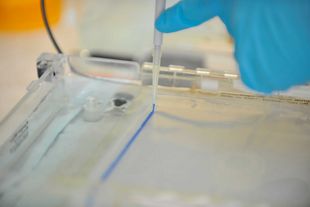Obesity and non-alcoholic fatty liver disease are two of the main risk factors for type 2 diabetes. If obese individuals develop diabetes, it needs to be detected quickly. Of note, early treatment can prevent diabetic complications. In the journal Molecular Metabolism, researchers report on an epigenetic biomarker that can predict existing type 2 diabetes.
Epigenetic changes enable the DNA to react to environmental influences. A methyl group, linked to a specific DNA sequence, can block or enable the transcription of genes. The epigenetic changes which occur in tissues and or blood cells of a person can determine their eating habits and other aspects of their lifestyle, among other things. Epigenetic factors also play a role in the development of obesity and diabetes.
To find an early and easily-measurable biomarker for the risk of diabetes, researchers at DZD’s partner institution – the German Institute of Human Nutrition (DIfE), Helmholtz Munich, and the associated partner in Lubeck, initially examined the DNA of obese mice.
Comparison of mice with different diabetes risks
Despite their obesity, due to slight differences in their liver fat content, the female mice that were examined had very different diabetes risks: While one group was diabetes-resistant, the other group was especially susceptible to diabetes.
An analysis of gene expression and DNA methylation in the livers of the rodents showed that the HAMP gene expression was reduced by about 50% in diabetes-prone mice in comparison to the diabetes-resistant group. Increased DNA methylation of multiple sites in the gene promoter were found to be the cause for the decreased expression.
HAMP encodes the iron-regulatory hormone hepcidin, which had a lower abundance in the livers of mice prone to developing diabetes.
Confirmation using human test individuals
The researchers also analyzed tissue samples from the livers of obese, insulin-resistant women. They determined that in these individuals, expression of the HAMP gene was significantly downregulated along with increased DNA methylation levels in the promoter at the same sites as the animal model.
However, an easily measurable biomarker should also be easy to access, such as through a blood sample. Therefore, the researchers also analyzed the DNA methylation of the HAMP gene in blood cells, which were taken around four years before the diabetes diagnosis of participants in the prospective EPIC-Potsdam cohort. This also showed a strong association between the methylation at certain CpG sites of the HAMP gene and an increased risk of incident diabetes.
Early marker for existing cases of diabetes
The researchers concluded that their investigations provide new insights into the epigenetic changes of the HAMP gene before the development of type 2 diabetes. The findings also demonstrated that HAMP, or its epigenetic changes, could serve as an early marker for existing type 2 diabetes.
Original publication:
Meriem Ouni, Fabian Eichelmann, Markus Jähnert, Christin Krause, Sophie Saussenthaler, Christiane Ott, Pascal Gottmann, Thilo Speckmann, Peter Huypens, Stefan Wolter, Oliver Mann, Martin Hrabé De Angelis, Johannes Beckers, Henriette Kirchner, Matthias B. Schulze, Annette Schürmann. Differences in DNA methylation of HAMP in blood cells predicts the development of type 2 diabetes. Mol Metab 2023 Sep; doi: 10.1016/j.molmet.2023.101774.

